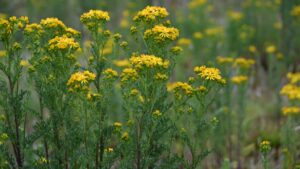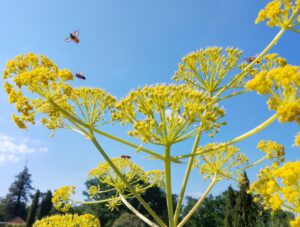
Podcast Episode 36 – The Dove From Above
PODCAST EPISODE 36: The Dove From Above Join us on a beautiful June evening for episode 36 of the Knepp Wildland Podcast. We’re joined by
Home / The Journey to Wilding the Garden ~ March 2022
The speed of life burgeoning at this time of year always catches us unawares: the tilt towards the sun seeming to come all at a rush, and the Spring Equinox holding the promise of long warm days to come. As lengthier days stimulate the reproductive hormones of birds we know that nesting time is almost upon us and any potential sites need to be pruned now to keep disturbance to a minimum. The flowers of the ivy ‘umphs’ – the irregular mounds surrounded by similarly shaped box on the terrace – are cloaked now in umbrellas of green seedheads, but last year’s growth is pushing into the topiaried box, depriving them of light and air. Shaping the ivy means we keep the foliage dense in the centre making good all-year cover for wildlife – both insects and birds – as well as creating a blanket of flowers late in the season, just as insects are needing that final nectar boost before hibernation.

The ivy, box and yew ‘umphs’ on the terrace
Under the oaks next to the terrace our attention is taken by the fallen colossus, the elderly giant oak that came down in the summer storms of 2021. Rather than cutting and clearing, we had looked on this as an opportunity: a creation of a whole ecosystem absent in the rest of the garden. From the deeply grooved bark now available to invertebrates along the whole length of the trunk; to the dead wood – both dry and wet – providing food and shelter for fungus and saproxylic insects; to more diverse wild plant species appearing with greater light levels, this happy accident is a boon to the garden as a whole.
During garden safari tours last year some visitors doubted they would be able to reconcile the aesthetic of a fallen tree in their own gardens. Now the smaller limbs and twigs around the crown have lost their leaves and settled like some enormous, ungainly wood pigeons’ nest, our discussion turns to ‘the limits of acceptable change’, as Professor Mick Crawley from our advisory board puts it. If this tree were in the wider landscape, the free-roaming herbivores would have stripped much of the young green limbs and trampled the remains underfoot, as well as using the sturdier limbs as scratching posts. The effect would leave a cleaner edged, more architecturally sculpted form. As gardeners, should we leave well alone or dress the scene, mimic the herbivores as agents of disturbance in our tidying and arrange the crown as such? Our decision (the latter) was based on our place in telling the story of our journey here; it’s important for us to bring people along with us, particularly those with more traditional horticultural views and for visitors to be able to move safely in amongst a natural work of art.
We asked similar questions of ourselves concerning the dead winter stems and seedheads in the kitchen garden, the aesthetics of some windblown and ragged frost-protection mounds, decidedly offensive. The stately seven-foot artichokes still boast heads of fluffy seed bombs; and the bergamots’ chocolate-brown stems tied together like corn sheaves are still giving both height and visually pleasing interest. It is their dry, hollow niches and dark, moist hiding places that keep the garden’s habitat diverse, giving migrating birds a supply of food before the new season’s invertebrates emerge, and encouraging them to nest nearby and keep a predator/pest balance in the garden. How long can we hold out on the perceived ‘untidiness’? We decided on a staged tidy, clearing around the edges of some, and removing others, leaving what we could. We preferred a steady approach rather than a wholesale cut-and-clear of all the dead. Every gardener will have their own limits, and our views are beginning to change as we try to see ourselves as part of the ecosystem.
The discussions on the nature of wilding and gardens continued as the garden’s designer Tom Stuart Smith and co-conspirator in planting, Professor James Hitchmough, arrived to lay out the last of the bulk delivery of plants, numbering just over 2,000. They were pleased to see how well the plants were doing in the sand and crushed concrete of the Pool Garden that were planted in November. As James said, the aggregate mulch is not the definitive answer, it is part of a conversation about how to expand opportunities in a garden. By presenting this ‘box of experimentation’, binary ideas of good and bad are challenged and, we hope, will prompt its viewers to ask questions.
From one side of the Kitchen Garden’s long, shady, moist and nutrient-rich stable yard bed, through grit and topsoil mixes and the dirty paths of gravel- topped beds, and into the stony slopes and ridges of the Pool Garden and its ephemeral pond, the garden presents a range of diverse habitats. The nutrient-dense areas are rich in resources which can lead to dominance by a few species above ground and a greater diversity below. In the nutrient-poor garden those dominators are slowed down and the 500 different taxa have a competitive edge, the resources being scarcer.
Some time was spent on hands and knees among the rocky concrete backbone of James’ planting range, scanning for early seedlings from the overlaid seed mix spread in early December. A shout of recognition erupted from James: one of the Pentstemon species had been spotted. This is particularly exciting as they are a good indicator that we have created the right growing conditions, similar to their native North American desert or alpine homes. The plant community of seeds that hail from the same terrain should follow, although many of the forty-two mainly perennial species are unlikely to germinate before April or May. We plan to regularly roam this stretch to familiarise ourselves with the inevitable weed seedlings and distinguish them from sown plants to help with early establishment. We had already put in place a daily irrigation regime to keep the top inch of sand moist and ensure initial success, reducing future maintenance.

James Hitchmough and Tom Stuart-Smith scanning for seedlings in the crushed concrete and sand of the Pool Garden
As well as filling gaps throughout the new design Tom laid out the remaining two sections in the garden that have been bare over the winter, filling up the old Acacia Walk linking the Kitchen and Pool gardens, and the warm south-facing Peach House bed, adding some of the tender species we’ve been hardening off from their winter in the greenhouse. Under the pergola, he had brought some fascinating species of Aspidistra, A. mushaensis ‘Wulshe Wacky’ and A. daiuensis ’Yuli Yummy’ – the former species new to cultivation from the Central Mountains of Taiwan, with upright leaves up to a metre long, and the latter, from the southern area of Yuli, having leaves spotted and streaked with white. Tom placed them in the shady, dry corner amongst marigold-leaved beesia Beesia calthifolia and Fatsia polycarpa. In the central dip of the ephemeral pond, Iris siberica ‘Silver Edge’ and dark solid chunks of the roots of Darmera peltata augmented the Chinese silver grass, Miscanthus sinensis ‘Ferner Osten’. Considering the fluctuation of water levels over the winter, ranging from a metre’s depth to a few centimetres, the grasses have coped amazingly well.


The old Acacia Walk laid out to plant and, right, garden volunteers Jayne, Jody and Luke getting the new arrivals into the ground
So, too, did the fabulous group of garden volunteers who helped plant the new arrivals in the following days, battling snow flurries, alarming gusts of cold winds and penetrating rain showers swiftly followed by confusing bursts of bright sunshine. With their help we soon came to a satisfying sense of turning a corner, only a few labels indicating missing species dotting the garden. Surveying the scene, the greens were already starting to compete with the buff and chromes of the sand and stones. In a matter of months, all will change again, a constantly varying mosaic of colours and flowers, heights and leaf shapes, scents and sounds. With so much to look forward to exploring and hundreds of relationships to observe, it looks like it’s going to be a lively summer.
Moy Fierheller Deputy Head Gardener March 2022
What we’re reading
BBC Radio 4 – Costing the Earth, Carbon Farming
Ballagh Botanicals/Micro Farm (@ballaghmicrofarm) • Instagram photos and videos
The Rhizosphere – Roots, Soil and Everything In Between | Learn Science at Scitable (nature.com)
Silo London (@silolondon) • Instagram photos and videos Invasive Species Dinner Menu

PODCAST EPISODE 36: The Dove From Above Join us on a beautiful June evening for episode 36 of the Knepp Wildland Podcast. We’re joined by

Matt Phelps | Lead Ecologist It’s mid-June and the countryside is quietly gearing up for its summer crescendo. You might have noticed it already— what

Moy Fierheller | Deputy Head Gardener Visit Knepp’s rewilded Walled Garden The fine, fairy-tale spring continues and the Met Office reports it’s the sunniest in
Knepp Wildland Safaris, our gardens and campsite are all about the quiet and patient observation of nature.
Some of the species we are likely to encounter are shy or can be frightened by loud noises or sudden movements. Our campsite with open-air fire-pits, wood-burning stoves and an on-site pond is unsuitable for small children.
For this reason, our safaris, garden visits, holiday cottages and campsite are suitable only for children of 12 and over.